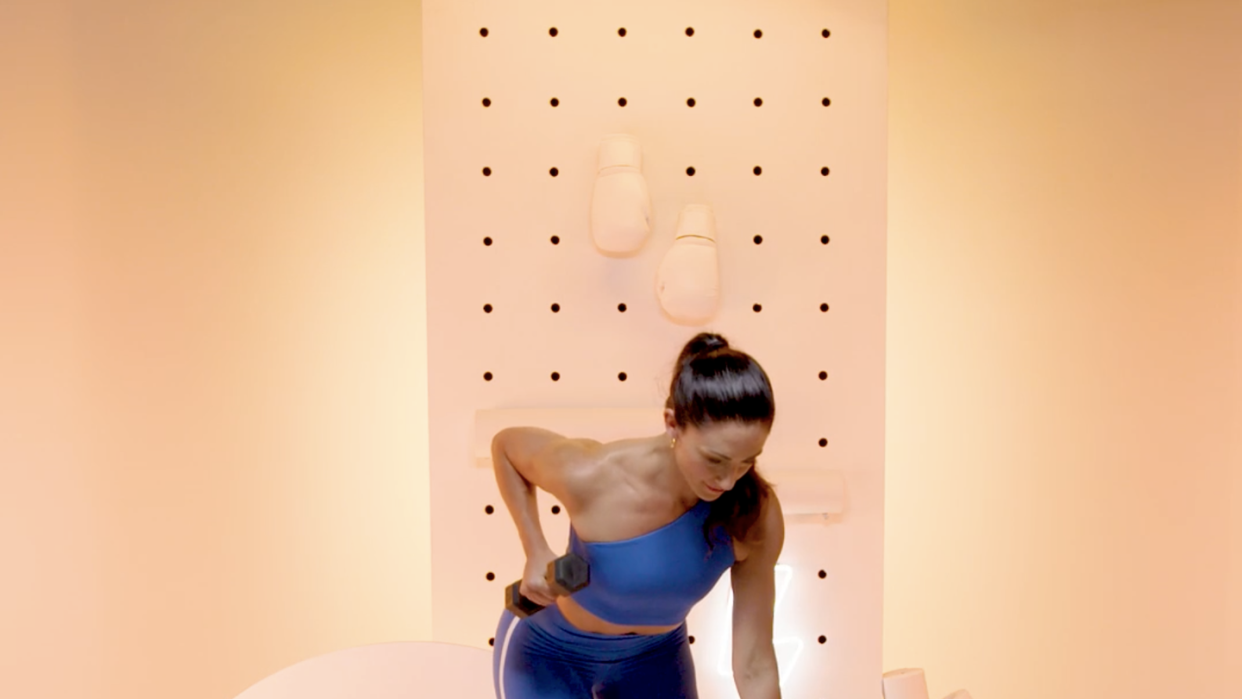This 2-For-1 Workout Tones Your Back And Arms In 15 Minutes

Raise your hand if you want to improve your posture and basal metabolic rate, increase your grip strength, and tone your arms. If your hand is in the air, it’s time you crush a back and biceps workout.
But the biggest perk of adding back and biceps exercises to your routine may be that doing so protects your spine. "All movement derives from your spine, and if your back muscles are weak, your spine is going to move more than it should leading to injuries and back pain," says Barry's trainer Meghan Voell, ACE-CPT. "Strengthening the muscles especially around the spine reduces your risk of back pain and injury. It improves your posture as well."
Combining your back and arm workout is also a smart and effective way to train, and any pull movement will hit both. "It's a time saver," says Voell.
Not to mention, strengthening your back and biceps helps the rest of your body perform at its peak. "Your body works like a pulley system," says Voell. "If one set of muscles is weak, you still have to complete movements and other muscles take on what those muscles should be doing. When your back is weak, typically your chest and shoulders get tight and come forward creating a hunched look, because they're compensating for what your back should be doing."
Keep reading for all the back and biceps anatomy deets you need. Then, grab a set of dumbbells and get ready for the best back and bi workout for a stronger upper body.
Meet the experts: Meghan Voell, CPT, is an ACE certified personal trainer and trainer at Barry's in Denver. Tatiana Lampa, CPT, is a certified personal trainer, corrective exercise specialist, and founder of Training With T. Samantha Rothberg, CSCS, is a certified strength and conditioning specialist and founder of Samantha Rothberg Fitness. Tina Tang, CPT, RKC, SFL is an NCSF-certified personal trainer, strength coach, and founder of Iron Strong Fitness.
Why should you train the back and biceps together?
Here’s the sitch: Muscles rarely act in isolation. When you’re training larger muscles like the back and performing compound movements, you have primary and secondary movers, says Samantha Rothberg, CSCS, founder of Samantha Rothberg Fitness. For example, think about a bent over row. Your primary mover is the rhomboids (located in the upper back), and your secondary mover is the biceps, she explains. “They work synergistically to execute the movement, and by training both together, you can maximize both effectiveness and efficiency in your workout.”
Another benefit? You’ll likely have a more balanced physique and strength development since training your back and biceps together targets both your anterior muscles (located on the front of your body) and posterior muscles (located on the back of your body), says Rothberg.
Anatomy Of The Back And Biceps
Back
Trapezius: Also known as the “traps,” the trapezius is a muscle group that covers the upper back and goes down along the spine to the mid-back, says Tina Tang, CPT, founder of Iron Strong Fitness. The traps are responsible for moving your shoulders in a shrugging motion and pulling your shoulder blades together, but they also support your posture, head rotation, and upper-body strength, she adds.
Latissimus Dorsi: The latissimus dorsi (aka the lats) are the largest muscles on your back and are crucial for spine stabilization and shoulder movement, says Rothberg. They’re found just below the shoulder blades and extend along the spine, down to the pelvis and across the back, and they’re essential for upper body strength, she adds.
Rhomboids: The rhomboids are a muscle group composed of the rhomboid major and minor, located between the shoulder blades, says Rothberg. They’re responsible for controlling your shoulder movement in conjunction with your traps and are vital for maintaining proper posture and shoulder stability, she adds.
Posterior Deltoids: Also known as the rear delts, the posterior deltoids are the muscles on the backside of the shoulders and are crucial for improving overall shoulder function and stability, says Rothberg. They also stabilize movement of the other muscles in the arm and back and allow your arm to lift out and externally rotate.
Biceps
The biceps (bi, meaning two, and cep, meaning head) are the anterior muscles of the upper arm, split into two heads: the long head and the short head, says Rothberg. The two-headed muscles are attached to the scapula and radius bone and are responsible for flexing and supinating the forearm and stabilizing the elbow joints, she explains.
15-Minute Back And Biceps Workout
Time: 15 minutes | Equipment: 5–10 pound dumbbells for beginner/intermediate, 12 pounds for advanced | Good for: Biceps and back
Instructions: Choose six moves below (three from the first five moves, and three from the last five). For each move, do three to four sets of 12 reps, resting as needed in between sets. Then continue to the next move.
How often should you work the back and biceps?
Generally speaking, you should work your back and biceps two to three times per week, says Rothberg. Just note that frequency is dependent on your goals, current fitness level, and/or specific training program, she adds.

What causes a weak back and biceps?
A sedentary lifestyle is the top culprit for a weak back and/or biceps, says Tang. Why? If you’re hunched over a desk or computer all day, the muscles in the front of your body shorten and the back muscles become lengthened and locked, exacerbating weak muscles, explains Rothberg. On top of that, a weak core can also contribute to a weak back since the deep core muscles are responsible for supporting and controlling the spine.

You Might Also Like
